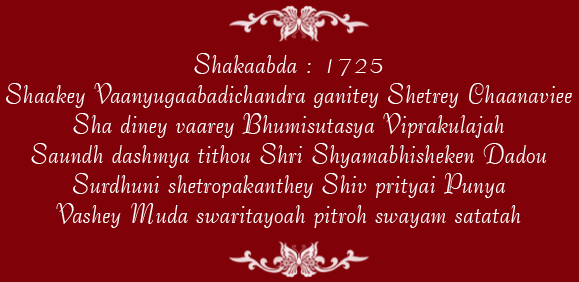
![]()
Our this Shri Jabreshwar Mahadev Mandir is not only popular in the locality but its extreme nationwide popularity also justifies its name "JABRESHWAR". The great image of this Temple is only due to the blessings of Lord SHIVA. This foundation results the base of history for Temple's establishment.
 We can get the information, regarding Temple's establishment, on the South (front) side of the Temple wall which is engraved on a stone written in Bengali having a Sanskrit meaning. You can see the glimpse of it in picture below:-
We can get the information, regarding Temple's establishment, on the South (front) side of the Temple wall which is engraved on a stone written in Bengali having a Sanskrit meaning. You can see the glimpse of it in picture below:-
The transliteration in English is as follows:-

The language used above was common during that period. To understand the exact meaning of its contents, we have to know some of the contemporary art of literature writing of that period. One great Scholar, who was very much familiar with this language Dr. Devnath Bandhopadyay, professor of Ravindrabharti Vishwavidyalay, elaborately explained the meaning of these words very kindly. We are grateful to him for this hard work and showing the path.
According to sources & information available, they were written backwards (instead of 'left to right' they were written 'right to left'), which is better known as "Ankasya Vaama Gati". Therefore the words in the first line 'Shaakey Vaanyugaabadichandra ganitey' means Shak Samwat 1725.
If we read them from left to right it will be 5271 but though they are written backwards it means 1725, the same year is mentioned on the top of the stone in Bengali and in figures.
After this, the translation of the Sanskrit words will provide us with the proper meaning. The word 'Shetrey' means The Month of Vaisakh. The word 'Chaanaviee Sha diney' means more nineteen days. The word 'Vaarey Bhumisutasya' means Tuesday. In this way, the day when this Temple was established is mentioned. This is nineteenth day of the month Vaishakh of year (Shak Samvat) 1725. Thereafter the Tithi (Hindi Calender's Date) of this day is also mentioned which is Dashami. After its calculation it is found that the day is 3rd may according to Bengali Calender 1210 and 1803 A.D. as well and this day also Tuesday. The above fact's confirmation is achieved from the Granths (series of Books) from which Time Calculation is done.
The name of the person who was creator and the donor for the establishment of Temple is written as 'Viprakulajah Shyamabhisheken Dadou Saundh', it means, Shri Syama Kaviraj who was born in Brahmin race who bestowed the Temple. The location of Temple is mentioned as 'Surdhuni shetropakanthey'. Surnidhi is better known as Ganga which is present in Narad Muni's melodious music of Veena and reaches to Lord Vishnu. Thus it means near the river Ganga, the place where Temple is today at Zakaria Street is not far away from the flowing river, so it may be possible during that period river was nearer to it.
The dignity of Lord SHIVA in Temple is written as 'Shiv prityai' and at last the words 'Punya Vashey Muda swaritayoah pitroh swayam satatah' it is being said that Pious spirits always stays here happily.
In this way, if we collectively read the whole text, the meaning is as follows:- The SHIVA Temple, near the bank of river Ganga, was established on the 19th day of month 'Vaisakh' in Shak Samvat 1725, Dashmi Tithi (Accordingly 3rd May of Bengali Calendar year 1210 & 1803 A.D as well), where the pious spirit came on there own and stay here.
Though, how Temple was built is mentioned on the engraved stone, but regarding its name, nowhere it is mentioned, which indicates that no particular name was given to it. At present the name being "JABRESHWAR" has a special reference behind it.
This context is related to some extreme mournful and painful memories. For the freedom of the motherland during the period of struggle with Englishmen, Muslim league on the basis of communal line spread mutinies for partition of this country and for fulfillment of same they started there agitation by direct killing of Hindus, on a very large scale on Friday 16th August 1946, which later on became popular by 'THE GREAT CALCUTTA KILLING'. During that period itself, the Temple was destroyed and the sign or SHIVA LINGA of Lord SHIVA was demolished. Later on peace prevailed. The devotees rebuilt and recreated the Temple. The SHIVA LINGA was placed by the help of the King of Burdwan. For the auspicious welcome of the Lord SHIVA's LINGA many devotees assembled, while unloading it from Lorry, every body was seeing the huge LINGA and one of the devotee from the crowd, Shri Radheyshaym Tiwari" who resided at Mandir Street, uttered the words "Yeh to bada Jabbar Mahadev hai" i.e This is a very huge SHIVA. These words touched everybody's heart and from there onwards the Temple's name become 'Shree Jabreshwar Mahadev Mandir'. The Temple was rebuilt and as the time passed it gradually increased and today this great structure is here.
The Temple is very lively. Daily many devotees come here. According to rituals, daily Pooja and Shringar are done. The responsibility of its security, pride and progress is naturally on us. All the devotees are very conscious towards it.
- An abstract from Annual Souvenir of Mandir Committee 2000